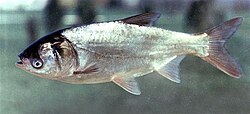Xenocyprididae
| Xenocyprididae Temporal range: | |
|---|---|
 | |
| Hypophthalmichthys molitrix | |
| Scientific classification | |
| Domain: | Eukaryota |
| Kingdom: | Animalia |
| Phylum: | Chordata |
| Class: | Actinopterygii |
| Order: | Cypriniformes |
| Suborder: | Cyprinoidei |
| Family: | Xenocyprididae Günther, 1868 |
Xenocyprididae,[1] is a family of freshwater ray-finned fishes commonly called the East Asian minnows or sharpbellies with a natural distribution in Asia. This taxon, sometimes spelt Xenocypridae, was previously regarded to be a subfamily, Xenocyprinae,[2] of the family Cyprinidae. Cyprinidae sensu lato is now divided into a number of smaller families within the suborder Cyprinoidei, in the order Cypriniformes.[3]
Genera
[edit]Xenocyprididae contains the following valid genera:[1]
- Anabarilius Cockerell, 1923
- Ancherythroculter P. L. Yih & C. K. Wu, 1964
- Aphyocypris Günther, 1868
- Araiocypris Conway & Kottelat, 2008
- Atrilinea Y. T. Chu, 1935
- Candidia D. S. Jordan & R. E. Richardson 1909
- Chanodichthys Bleeker, 1860
- Ctenopharyngodon Steindachner, 1866
- Culter Basilewsky, 1855
- Distoechodon Peters, 1881
- Elopichthys Bleeker, 1860
- Gymnodanio Y. F. Chen & S. P. He, 1992
- Hainania Koller, 1927
- Hemiculter Bleeker, 1860
- Hemiculterella Warpachowski, 1888
- Hemigrammocypris Fowler, 1910
- Hypophthalmichthys Bleeker, 1860
- Ischikauia D. S. Jordan & Snyder, 1900
- Longiculter Fowler, 1937
- Luciobrama Bleeker, 1870
- Macrochirichthys Bleeker, 1859
- Megalobrama Dybowski, 1872
- Metzia D. S. Jordan & W. F. Thompson, 1914
- Mylopharyngodon Peters, 1881
- Nipponocypris I. S. Chen, J. H. Wu & C. H. Hsu, 2008
- Ochetobius Günther, 1868
- Opsariichthys Bleeker, 1863
- Oxygaster van Hasselt, 1823
- Parabramis Bleeker, 1864
- Paralaubuca Bleeker, 1864
- Parachela Steindachner, 1881
- Parazacco Y. Y. Chen, 1982
- Plagiognathops Berg, 1907
- Pogobrama Y. L. Luo, 1995
- Pseudobrama Bleeker, 1870
- Pseudohemiculter Nichols & C. H. Pope, 1927
- Pseudolaubuca Bleeker, 1864
- Rasborichthys Bleeker, 1859
- Sinibrama H. W. Wu, 1939
- Siniichthys Bănărescu, 1970
- Squaliobarbus Günther, 1868
- Toxabramis Günther, 1873
- Xenocyprioides Y. Y. Chen, 1982
- Xenocypris Günther, 1868
- Zacco D. S. Jordan & Evermann, 1902
The following fossil genera are known:[4]
- †Ecocarpia Chen, Fang & Chang, 2005 (Oligocene of Guangxi, China)[5]
- †Eoxenocypris Chang, Chen & Tong, 1996 (Middle Miocene of Heilongjiang, China)[6]
- †Iquius Jordan, 1919 (Middle Miocene of Japan)[4]
- †Ikiculter Yabumoto, 2010 (Middle Miocene of Japan)[4]
A potential fossil genus of the Xenocyprinae is †Planktophaga Böhme et al., 2014 from the middle-late Eocene of Vietnam. Although initially classified under the East Asian group of Leuciscinae sensu lato (as Hypophthalmichthys was previously classified under it), it has unique pharyngeal teeth only shared with Hypophthalmichthys, and thus may represent a basal member of the group. Fossil teeth of indeterminate xenocyprines were found from the same site.[7][8]
Taxonomy
[edit]Xenocyprididae was previously considered to be a part of the family Cyprinidae, along with the Danionidae, Leuciscidae, Tincidae other related fish taxa. Eschmeyer's Catalog of Fishes place all of these groups, formerly considered to be subfamilies of the Cyprinidae sensu lato in the large, widespread and diverse suborder Cyprinoidei, consisting, mainly, of freshwater ray-finned fish.[3] This conforms with the classification adopted by other authorities.[9][10] The suborder Cyprinoidei is classified in the order Cypriniformes.[3]
References
[edit]- ^ a b Eschmeyer, William N.; Fricke, Ron & van der Laan, Richard (eds.). "Genera in the family Xenocyprididae". Catalog of Fishes. California Academy of Sciences. Retrieved 19 January 2025.
- ^ Nelson, J.S.; Grande, T.C.; Wilson, M.V.H. (2016). Fishes of the World (5th ed.). Hoboken, NJ: John Wiley & Sons. p. 186. doi:10.1002/9781119174844. ISBN 978-1-118-34233-6. LCCN 2015037522. OCLC 951899884. OL 25909650M.
- ^ a b c "Eschmeyer's Catalog of Fishes Classification". Eschmeyer's Catalog of Fishes. California Academy of Sciences. Retrieved 19 January 2025.
- ^ a b c Yabumoto, Yoshitaka (2010). "Ikiculter chojabaruensis , a New Genus and Species of Cyprinid Fish from the Miocene of Iki Island, Nagasaki, Japan". Paleontological Research. 14 (4): 277–292. doi:10.2517/1342-8144-14.4.277. ISSN 1342-8144.
- ^ Chen, Gengjiao; Fang, Fang; Chang, Mee-Mann (2005-01-01). "A new cyprinid closely related to cultrins+xenocyprinins from the mid-Tertiary of South China". Journal of Vertebrate Paleontology. 25 (3): 492–501. doi:10.1671/0272-4634(2005)025[0492:ANCCRT]2.0.CO;2. ISSN 0272-4634.
- ^ "Vertebrata Palasiatica". www.vertpala.ac.cn. Archived from the original on 2025-04-24. Retrieved 2025-06-29.
- ^ Böhme, Madelaine; Aiglstorfer, Manuela; Antoine, Pierre-Olivier; Appel, Erwin; Havlik, Philipe; Métais, Grégoire; The Phuc, Laq; Schneider, Simon; Setzer, Fabian; Tappert, Ralf; Ngoc Tran, Dang; Uhl, Dieter; Prieto, Jérôme (2013). "Na Duong (northern Vietnam) - an exceptional window into Eocene ecosystems from Southeast Asia". Zitteliana. A (53): 120–167. doi:10.5282/UBM/EPUB.19019.
- ^ Chen, GengJiao; Chang, Mee-Mann; Liu, HuanZhang (2015-07-01). "Revision of Cyprinus maomingensis Liu 1957 and the first discovery of Procypris-like cyprinid (Teleostei, Pisces) from the late Eocene of South China". Science China Earth Sciences. 58 (7): 1123–1132. Bibcode:2015ScChD..58.1123C. doi:10.1007/s11430-015-5085-7. ISSN 1869-1897.
- ^ Thomas J. Near; Christine E. Thacker (2024). "Phylogenetic Classification of Living and Fossil Ray-Finned Fishes (Actinopterygii)". Bulletin of the Peabody Museum of Natural History. 65 (1): 3–302. doi:10.3374/014.065.0101.
- ^ Betancur-R, R.; Wiley, E.O.; Arratia, G.; et al. (2017). "Phylogenetic classification of bony fishes". BMC Evolutionary Biology. 17 (162): 162. Bibcode:2017BMCEE..17..162B. doi:10.1186/s12862-017-0958-3. PMC 5501477. PMID 28683774.



 French
French Deutsch
Deutsch